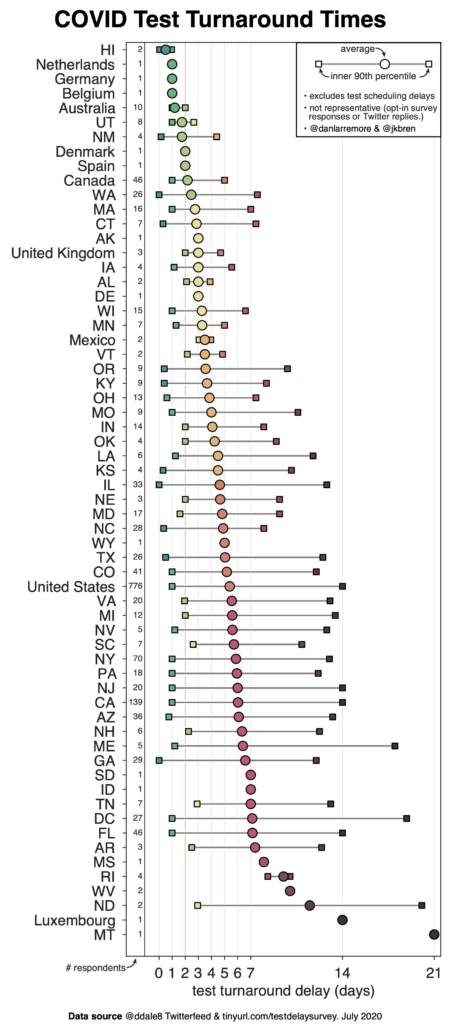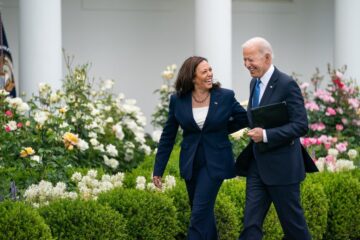Welcome back to Week 15 in my weekly reports analyzing the Covid-19 pandemic and its effects on the country, higher education and study abroad. For those of you reading this on my blog, Off the Silk Road, I have also launched a newsletter, where these reports can be sent directly to your email each week. Click here to subscribe.
I’m back after a three-day vacation over the long weekend, where I conducted some informal research on mask-wearing tendencies in Maine (for the most part, they were high). Last week, we discussed “reset and reverse” as cases continued to spike. This week’s theme is “cut the noise.” As there is so much information out there each week, I have edited this report to its most vital elements in an attempt to pioneer a new brief format.
There is a lot of material to go through (as per usual), so let’s get straight to it.
A national look
For the sake of brevity, I’ll divide this week’s discussion into three parts:
- How did we get here?
- What does the science say?
- What can we do about it?
In many places, the virus is still surging out of control. Daily case counts nationwide are still in the 60,000 mark. Florida and California have surpassed New York in the total number of confirmed infections. There are still reports of PPE shortages. Hospitals are running out of staff. While you can make a ventilator, you cannot make a doctor or nurse. This is the national picture we face, no matter what the White House says. Test results include long delays to return (up to two weeks), partially due to a shortage in supplies, and thus have become useless. Testing is so backlogged that diagnostic tests essentially have the same role as antibody tests — they’re diagnosing infections from weeks ago. I recently took a PCR diagnostic test. 13 days later, I am still waiting for results. Just look at these testing turnaround times.

Did we see a change in tone with Trump’s new coronavirus briefings this week? I’d argue not; this shift from the administration was only motivated by low poll numbers. This is failure in leadership, no matter how you spin it. There’s a lot more to our national picture, but given that news becomes obsolete within a few days, I will avoid including many of the details in this week’s report. Let’s check out some new scientific evidence that helps us better understand the virus.
- Aerosol transmission is possible.
- In a study from 10 U.S. cities, 10 times more people were probably infected than previously reported, with one city having 24 times the seroprevalence as official infection count.
- Antibodies may only last three months, with mild cases losing traceable antibodies in 36 days. This doesn’t necessarily mean achieving immunity is futile, depending on T cell reaction.
- If people washed their hands regularly, wore masks, and kept their social distance from each other, a large epidemic could be prevented by 50%.
- More than 1 in 5 U.S. homes, housing about one quarter of all Americans, lack sufficient space and plumbing facilities to comply with recommendations to isolate or quarantine to limit household spread of Covid-19.
- Most states are failing to report data critical to controlling the pandemic, including test turnaround times, according to former CDC director Dr. Tom Frieden.
- In a CDC survey of symptomatic adults who had a positive outpatient test result for SARS-CoV-2 infection, 35% had not returned to their usual state of health when interviewed 2–3 weeks after testing.
Let’s take a moment to discuss K-12 schools. An analysis by the Harvard Global Health Institute says that “the single best policy to support school reopening prior to the development of a vaccine or treatment is suppression of Covid to near zero case incidence.” How do we do that? Continue doing everything other countries and some states have been doing. Deem every entity of society as essential or non-essential. Close the non-essential businesses and get transmission down enough where it is safe to open schools. These decisions should be based on risk. Bars? High risk, non-essential. Supermarkets? Relatively low risk, essential. Researchers divided counties into red, orange, yellow and green based on new cases per 100,000 people. This has implications for K-12 schools, as seen as this map. Researchers recommend that for counties in red, all learning should be remote. For counties in orange and yellow, researchers recommend prioritize in-person learning with lower grades and special needs students.
Very few Americans back a full school reopening, as seen in this graph. According to the AP, “Only about 1 in 10 Americans think daycare centers, preschools or K-12 schools should open this fall without restrictions, according to a new poll from The Associated Press-NORC Center for Public Affairs. Most think mask requirements and other safety measures are necessary to restart in-person instruction, and roughly 3 in 10 say that teaching kids in classrooms shouldn’t happen at all.”
How are Americans adhering to social distancing? According to a Gallup poll, it seems that women, those with a college degree and Democrats show closer adherence to social distancing behaviors.
This leads us to our final question: What are we going to do about it? Dr. Leana Wen, former Baltimore health commissioner, lists three options the U.S. can take:
- Status quo
- Full shutdown
- Whack-a-mole
She writes: “Is the specter of ‘status quo’ bad enough to force an urgent course correction, or will complacency continue until death hits home for more families? It would take a lot to switch to “whack-a-mole” — and a ‘full lockdown’ would save even more lives. Either way, we need to muster our collective willpower if we are to stop the death toll and destruction of covid-19.”
Dr. Peter Hotez, Professor of Pediatrics and Molecular Virology & Microbiology at the Baylor College of Medicine, has published a plan to contain the virus by October 1. One definition of containment is one new case per million residents per day. For the U.S. to achieve this level of containment, we would need to have under 330 new cases nationwide per day. Sound interesting? Let’s see what Dr. Hotez says we need to do.
- Shape a national plan with an objective of a national level of containment.
- Some experts benchmark containment as one case per million residents per day, but we might select less strict criteria.
- Upon achieving this level, it would be possible to reopen schools, colleges, and businesses safely, provided a full and functioning health system is in place.
- With containment, contact tracing actually becomes feasible, whereas this is not the case currently across most of the nation.
- Each state would either agree or be required to meet that containment benchmark.
- Some of these states, such as those in northern New England (NH VT ME) might already be close to that level. Others, such as FL TX AZ may require aggressive stay-at-home measures.
- Starting October 1, we could begin a national reopening for schools, colleges, and even outdoor high school (“Friday Night Lights”), collegiate and professional sports.
I’d liken this plan to a Paris Climate Accord approach to the pandemic. Each state would buy into a benchmark and if we make these decisions now, we can safely reopen our economy and stop close to 1,000 people from dying every day. “Doing nothing or continuing a strategy based on states in the lead will only invite further tragedy. By late in the fall every American will personally know someone who is severely ill or hospitalized,” Dr. Hotez writes.
Let’s finish this week’s national discussion with some vaccine updates.
- Moderna has started Phase III trials with up to 30,000 people on July 27.
- A vaccine made in Wuhan has mounted a robust immune response.
- Pfizer and German biotechnology firm BioNTech will supply the federal government with 100 million doses of their coronavirus vaccine under a $1.95 billion deal, promising free or low-cost vaccinations for Americans.
- Preliminary results of a Phase I/II trial of a coronavirus vaccine developed by the University of Oxford suggest that it is safe and induces an immune response.
Yes, we are cautiously optimistic that a vaccine will come. But not in time to open schools for the fall. We need to be acting now to reduce transmission. Are we seeing a turning point? We need to get our hospitalizations down first.
Having laid down the groundwork on the national scene, let’s take a look at the latest developments in higher ed.
Higher education
In my view, we are now seeing main factors behind colleges reconsidering plans for the fall.
- Worsening national situation (higher ed does not operate in a vacuum)
- Cost of implementing a safe and secure campus
- State quarantine restrictions
“We can’t count on the public policy environment to reinforce or guide our decision making,” Morehouse College David Thomas told The Chronicle of Higher Education’s Lindsay Ellis. “At the same time, we do not have access to the things that would help us control the prevalence of the pandemic on our campus, including quick, large-scale asymptomatic testing and contact tracing,” Randolph College president Bradley Bateman said. It is worth noting that Liberty University, located in the same town as Randoph in Lynchburg, Virginia, has set a trigger of 5% of the student population testing positive to pivot to online instruction. With a student body of 15,000, that trigger would be 750 infected people, a huge outbreak. Students coming to Syracuse University from 22 states on New York Governor Andrew Cuomo’s travel advisory list must pay for quarantine housing themselves for 14 days. A similar situation exists at the University of Pittsburgh. Testing strategies vary widely among colleges. As Sarah Brown reports in the Chronicle, off-campus outbreaks can be hard to control.
For those continuing to reopen, reopening plans have turned downright wacky. This week’s winner of the college ridiculist is Boston University. As reported by my colleague Grace Ferguson, “This fall, reduced elevator capacity is going to change the way students move around buildings. Students who live on the first four floors of high rises will be expected to take the stairs. And even students on upper floors will be encouraged to take the stairs on their way down.” At Ohio State University, couches are being removed.
Some colleges have now chosen to delay reopening, starting classes online and then moving in-person, hoping that the situation in their locality will be more under control by then. “We should have prioritized in-person instruction for schools and de-emphasized it for higher education. Instead, we seem to have done the opposite,” higher ed professor Brendan Cantwell writes. This map shows 50 colleges I have been tracking that have made changes to their fall plans.
“College campuses that are reopening for in-person instruction are banking on the personal responsibility of students to make it all work—and students are being set up to take the fall when the plans fail,” an epidemiologist and a psychologist write in The Atlantic.
It’s worth noting that for those colleges that have gone predominantly remote, one anecdote shows that the number of students taking the semester off is lower than expected (with the highest proportion in the junior class), as reported by my colleague Kate Lusignan at Bowdoin College.
So what do the students think? Here are some samples from op-eds and editorials in student newspapers this week.
- “The university has a one-track mind, intent on hosting students for in-person learning despite clear health risks, all the while asking students to pay extra to partake in the risk only weeks before the semester is slated to begin,” the editorial board at Syracuse University writes.
- “Any cases that result from the return to campus and the deaths that follow will have been entirely preventable,” editors at Kansas State write.
- “Emory put me at an unnecessary risk and forced me to choose between my health, finances and academic progress,” one student at Emory University writes.
- “By bringing quarantine-fatigued students back together from all over the country, UT is inviting a high risk,” one UT-Austin alum writes.
- “Going to school with COVID-19 restrictions would definitely not be ideal, but the current plan just seems to promote an environment festered with academic floundering and exhaustion,” one Brown University incoming student writes (first-years at Brown will not be on campus until next spring, according to the university’s plan).
- “I would love to stay at home and social distance, but I either do that and withdraw from the semester or put myself at risk,” one University of Iowa student says.
How do faculty and staff feel?
- “If Houston does not become demonstrably and sustainably safer in the next two weeks, I strongly urge Rice to re-evaluate the decision to bring back to campus a majority of the undergraduate population,” one Rice University faculty member writes.
- “It’s unconscionable that UM’s higher administration is basically telling the faculty, ‘Get in that classroom; hope you don’t die,’” one history professor at the University of Miami said.
- “There is no hope for compliance…The fact is it’s not going to work, and if it’s not going to work, it’s going to kill workers.” one groundskeeper at the University of North Carolina said on students wearing face masks.
- “I’m scared to death,” a custodian at UT-Austin said.
- One Stanford medicine professor urges those making decisions to not only consider infection rates but also sacrifice to students’ educational experience. “The unidimensional discussion of the coronavirus allows us to ignore these other costs, and I wish that there is a more balanced consideration of what it means for Stanford to have more infections,” he said. “What number of infections would be acceptable in order to allow students to have their college experience?”
For the athletes who are already on campus, how is that working out for them? I have tracked 708 cases in college athletics so far, almost reaching the number of confirmed cases on the Diamond Princess cruise ship in February — 712.
We’re running out of time here for colleges to make decisions. I expect we’ll see more walk back reopening plans over the next couple of weeks. For the rest, we should expect for them to prepare to potentially start counting confirmed cases once the semester starts. In many areas of the country, we have not achieved the desired level of suppression to safely open a residential college.
Study abroad and international travel
Last Friday, Immigration and Customs Enforcement stated that newly enrolling international students will not be allowed to come to the U.S. if their courses will be taught entirely online. As higher ed reporter Karin Fischer points out, this now means that there are essentially two visa policies for international students, one for new students and one for returning students.
Other notable updates in global education are as follows:
- NYU Shanghai will welcome some 2,300 Chinese undergraduates and 800 graduate students from NYU in New York and NYU Abu Dhabi for the fall semester. It is worth nothing that NYU is home to the highest number of international students in the United States, with over 17,000 international students and scholars from over 140 different countries.
- Harvard College will allow returning international students to transfer credits from an accredited university in their home country to Harvard this fall, as reported by my colleagues Juliet Isselbacher and Amanda Su.
The Good Stuff
Let’s roll the clips of the good stuff. In my usual tradition, I feature my favorite stories from the week. Here are my Top 12.
- Dr. Anthony Fauci threw out the first pitch at the Washington Nationals game last Thursday, and let’s just say he doesn’t want anyone catching anything. His baseball card has now becoming one of the best selling in history.
- A 94-year-old ‘Rosie the Riveter’ once made warplanes and red bandanas. Now she makes face masks with the same cloth.
- A New Yorker staff writer drove cross-country in the middle of the pandemic.
- The inflatable pool is the official symbol of America’s lost summer.
- “Sweet Caroline” plays to an empty stadium at Fenway Park.
- The New York Times Book Review team continues to review books from home.
- Creative dressers find hazards in social distancing fashion.
- With recent grads home indefinitely, parents and ‘kids’ navigate life together.
- Pentatonix’s Scott Hoying performs a parody of the opening song in “Hamilton” about Dr. Fauci.
- Puppies play in the water.
- Inventions made by researchers at Brown University have been vital to diagnosing and treating Covid-19.
- Seasonal summer jobs have become a nostalgic relic of the past for many of today’s young people.
Conclusion
Could we see a national turning point? It’s too early to tell. For many places in our country, the virus continues to spread out of control. Hospitals continue to be overwhelmed and testing, the backbone to any sort of an effective response, is breaking down. Only when we fix these critical healthcare problems will we be able to suppress the virus and be in a better place to open colleges in the fall. Let’s spend the next two months making sacrifices for our future. Opening in-person in a delayed fashion could be a new strategy for colleges, and it is one that we should strive for. We are running out of time, and all the president is thinking about is “Person, Woman, Man, Camera, TV.”
I’d like to thank all the student journalists with whom I have the pleasure of working. In the next weeks and months ahead, they will become ever more important in chronicling their colleges’ decisions for the fall and beyond. Support their work by reading it.
My best to all for good health.
Do you like this new in-brief format? Like what you see? Don’t like what you see? Want to see more of something? Want to see less of something? Let me know in the comments. And don’t forget to subscribe to the weekly newsletter!
For more instant updates, follow me on Twitter @bhrenton.


